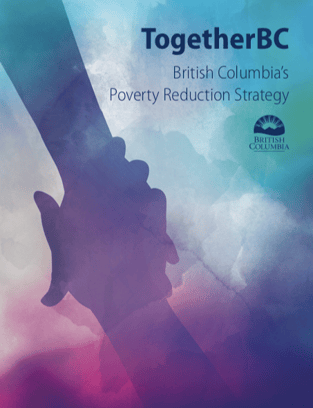 British Columbia’s first poverty reduction strategy, TogetherBC, sets a path to reduce overall poverty in B.C. by at least 25% and child poverty by 50% by 2024. These targets were legislated in the Poverty Reduction Strategy Act, with measures aligned with Opportunity for All, Canada’s first poverty reduction strategy.
British Columbia’s first poverty reduction strategy, TogetherBC, sets a path to reduce overall poverty in B.C. by at least 25% and child poverty by 50% by 2024. These targets were legislated in the Poverty Reduction Strategy Act, with measures aligned with Opportunity for All, Canada’s first poverty reduction strategy.
TogetherBC was guided by an extensive engagement process. It is based on the principles of Affordability, Opportunity, Reconciliation, and Social Inclusion, and encompasses 12 key priorities distilled into six priority action areas.
“Together, we can build a fairer province by bringing down barriers and giving people the services and supports they need to break out of the cycle of poverty. TogetherBC is our roadmap for a better British Columbia, where everyone, regardless of their background or income, is treated with dignity and has access to opportunity.” – Shane Simpson, Minister of Social Development and Poverty Reduction
On the May 2019 BC Communities Reducing Poverty Community of Practice (BC CoP) call, poverty reduction practitioners from across the province engaged in a discussion around what they were happy to see in the strategy, what they thought was missing, how they saw it supporting their goals on the ground, and how they could help roll out the strategy at a local level.

Members highlighted a number of aspects of TogetherBC that they appreciated most:
- Inclusion of Reconciliation and Gender Based Analysis Plus language
- The new B.C. Child Opportunity Benefit for families with children aged 6-18
- ChildCareBC, a roadmap to universal childcare, including the Affordable Child Care Benefit and a Child Care Fee Reduction initiative. One member from rural BC noted that under this area of work, their community will soon be able to open their first licensed child care space
- Annual increases in minimum wage to $15.20 by 2021, as well as improvements to employment standards and better protection for temporary foreign workers
- Restricting rent increases to 2% and expanding rental assistance beyond seniors
- Eliminating MSP premiums and deductibles for Fair PharmaCare
- Tuition waiver program for youth in care to pursue degrees, certification or trades training
- Eliminating interest on BC student loans
- Extending Family Program support rates by up to 75% for caregivers, and increasing rates for foster care parents to help keep children with their foster families, and to more readily recruit new ones
- Recognition of mental health and addiction as a Persistent Multiple Barrier, thus removing wait periods of 12-15 months for social assistance recipients
Despite increases to income assistance and disability rates, increased earning exemptions, and increased asset allowances, the biggest gap identified by members in the BC strategy was that benefit rates continue to keep recipients below the poverty line.
The successful rollout of TogetherBC is contingent on committed partnerships between governments, businesses, First Nations, community organizations, and people with lived/living experience. BC CoP members noted challenges in this regard, for example around keeping people informed of new and expanded benefits and credits, particularly for those that require enrolment or tax filing. In response, a few were improving local navigation supports, for example by raising community awareness, breaking down barriers one-on-one, and creating resource guides for workers and families.
In an effort to raise awareness of issues relevant to their own community, and to identify programs and services that could be implemented locally, one member made a presentation to his Mayor and Council. Using the provincial strategy as a leverage tool, he advocated that in light of the recently released Canadian and BC strategies, now was the time for their community to invest in a local poverty reduction strategy.
Take Your Learning Further:
- Here's a look at BC's First Poverty Reduction Strategy, TogetherBC
- News Release - Province launches first poverty reduction strategy, TogetherBC
- Check out this Toolkit: What Municipalities Can and Can’t Do to Prevent and Reduce Poverty in our Communities (BC Poverty Reduction Coalition)
- Media releases:





